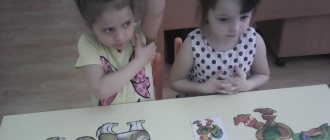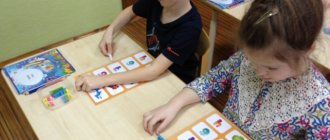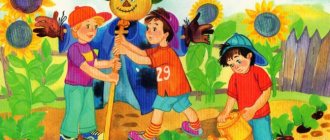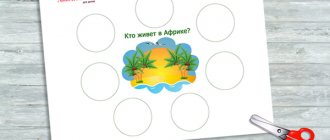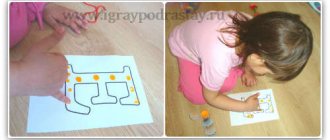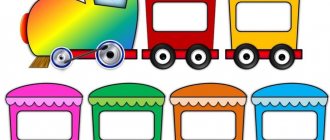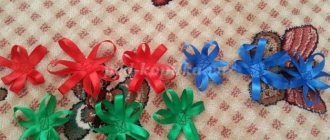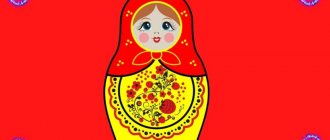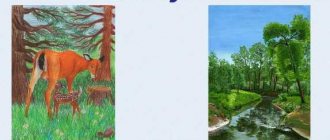Making pictures from parts
There is a lot of literature on this topic, I use these manuals:
- Children's health kit;
- A set of pictures on social development
- Illustrations on children's speech activity.
I also use homemade materials in my work, download pictures from the Internet and make games. So, that was a small digression, let's get back to the topic of conversation.
A drawing that is divided along straight lines into several parts is split. A preschooler should not think about the shape of a detail in a drawing; he concentrates on the full image.
When a child collects a drawing, he must imagine what he is collecting, what image he will get. In this case, he must correlate the pieces with the image so that the correct place is allocated to it. Otherwise the illustration will not work. This requires concentration, seriousness, and attentiveness from children.
When folding cut images, the baby begins to realize the objective integrity and compose an illustration from parts. He trains his memory, develops thinking, and spatial orientation. Drawings are great for improving fine motor skills. By consolidating knowledge about objects and phenomena, assembling a whole from pieces, the goal of the cut-out pictures game is formed.
From simple to complex
At first it is better to use the simplest designs with a small number of individual pieces. The image should be familiar to the baby. A good option is two similar pictures, one of which is divided into 2 parts. In this case, one can be a sample.
After the child masters this fun, he will not need an example picture. For this game, drawings from coloring books or old books will be useful. It will be much more interesting if you draw them yourself. Use bright, but not irritating colors.
First, cut the images into two, then into three parts. Then increase the number of pieces gradually when the child folds the previous drawing on his own. You should know that the number of elements collected increases, and their size decreases. There are times when a baby puts together pictures with large pieces easier.
The number of items should be selected in accordance with the age and special qualities of your child.
Consultation for parents “Cut-out pictures at home and in the garden”
MUNICIPAL AUTONOMOUS EDUCATIONAL INSTITUTION
"Kindergarten No. 396", Perm
Consultation for parents of children of the second junior group
topic: “Cut pictures - at home and kindergarten”
Developed by teacher Bolshagina Svetlana Vladimirovna
Hello dear readers! An interesting option for didactic games are cut-out pictures, we’ll talk about this today. But first I want to ask you, do you use this game with your children and grandchildren? Where do you get the pictures? How do children behave in the game?
Cut picture
is a picture
cut
along straight lines into a different number of parts. The child does not have to think about the shape of the parts and can focus only on the image.
The purpose of cut pictures:
Teach your child to make a whole from several parts. In the process of playing with pictures, the child gets acquainted with the world around him, expands his vocabulary, activates speech, develops logical thinking and fine motor skills.
When a child collects a drawing, he must imagine what he is collecting, what image he will get. In this case, he must correlate the pieces with the image so that the correct place is allocated to it. Otherwise the illustration will not work. This requires concentration, seriousness, and attentiveness from children.
When folding cut images, the baby begins to realize the objective integrity and compose an illustration from parts. He trains his memory, develops thinking, and spatial orientation. Drawings are great for improving fine motor skills. By consolidating knowledge about objects and phenomena, assembling a whole from pieces, the goal of the cut-out pictures game is formed.
From simple to complex
At first it is better to use the simplest designs with a small number of individual pieces. The image should be familiar to the baby. A good option is two similar pictures, one of which is divided into 2 parts. In this case, one can be a sample.
After the child masters this fun, he will not need an example picture. For this game, drawings from coloring books or old books will be useful. It will be much more interesting if you draw them yourself. Use bright, but not irritating colors.
First, cut the images into two, then into three parts. Then increase the number of pieces gradually when the child folds the previous drawing on his own. You should know that the number of elements collected increases, and their size decreases. There are times when a baby puts together pictures with large pieces easier.
Very often in kindergarten I involve older children in making such games for younger children, and preschoolers are happy to help me. But at the same time, I am pursuing my goals, my task is not only to attract a child to artistic work, but also to teach how to cut paper, while developing children’s hands and fingers. The game of cut pictures is widely used in speech therapy activities with preschool children of the middle and senior groups. A speech therapist works with them and uses these games in his work. At every age, starting from 1.5 - 3 and continuing up to 7 years, the child is very interested in this fun, because with the help of it he learns the alphabet, toys, professions, transport, etc.
Method of playing the game
Having carried out the technique with cut-out drawings, for example, according to the seasons, you must first select pictures on this topic. The purpose of this method is to identify the skills of composing a whole image from parts. The task is to orientate by shape, color, size, identify visual figurative thinking, coordinate hand movements, as well as fine motor skills. How to do this fun?
Stimulus material.
Colored pictures cut into several parts. For 3-4 year olds - pictures cut into 2-4 parts, and for 4-6 year olds - pictures cut into 4-6 parts.
Instructions.
Look carefully at these cards. What do you think it is? What object is shown on them? Now fold these cards so that you get the item you named.
Carrying out the test.
The child is presented with cut-up images of objects one by one, from simpler to more complex. The cards are laid out randomly to make it difficult to understand. They offer to assemble the picture after the drawn object is recognized. If the child cannot determine what exactly is drawn on the cut-out pictures, help from an adult is possible, who pays attention to the most characteristic detail. If the image is not recognized before starting work, they suggest starting to collect the picture, and during the testing process (or after its completion), the adult once again asks the child whether he recognized the depicted object.
Analysis of results.
Children with normal mental development from the age of 3 put together a picture from two parts using the trial method.
After 4 years they move on to visual correlation. Pictures cut into 4 parts are offered from the age of 4; by the age of 5, the task is completed using the method of visual correlation.
When working with pictures cut straight into three parts, children often “lose” the middle part, shifting the beginning and end of the image, but when surprised and asking, “Where should we put this piece?” fix the error themselves.
Children with mental retardation can assemble a picture of two parts by the age of 4; a picture of 4 parts can cause difficulties for them even at the age of 5. After showing the method of action (the adult collects, shows the child, and then destroys the picture), the child completes the task. Children are distracted, may not complete the task, and require organizational help and support.
Cutting pictures for kindergarten
Very often in kindergarten I involve older children in making such games for younger children, and preschoolers are happy to help me. But at the same time, I am pursuing my goals, my task is not only to attract a child to artistic work, but also to teach how to cut paper, while developing children’s hands and fingers.
Pay attention to the “Games” section, where you will find a lot of useful material.
The game of cut pictures is widely used in speech therapy activities with preschool children of the middle and senior groups. A speech therapist works with them and uses these games in his work.
At every age, starting from 1.5 - 3 and continuing up to 7 years, the child is very interested in this fun, because with the help of it he learns the alphabet, toys, professions, transport, etc.
For preschoolers in the preparatory group, it is interesting to conduct such fun activities in mathematics. When compiling examples, I use the following pictures: in the upper part, for example, animals, toys or any objects, and in the lower part there is a number with the number of objects depicted in the picture. Such cut-out pictures for preschoolers can also be used to compose problems. An important indicator for assessing intellectual development in children is the success of putting together pictures from parts.
Methodology “Cut pictures”
S. Zabramnaya
(perception)
Purpose: to identify the level of development of a child’s holistic perception of an object picture.
Age : 3-7 years.
Stimulus material: object pictures, cut diagonally.
Examination procedure: the psychologist shows the child four parts of a cut picture and asks him to put the whole picture together: “Make a whole picture.” Education
: the psychologist shows how to connect the parts into a whole. After this, he again invites the child to complete the task independently.
Interpretation: Children with normal mental development from the age of 3 put together a picture from two parts using the trial method. After 4 years they move on to visual correlation. Pictures cut into 4 parts are offered from the age of 4; by the age of 5, the task is completed using the method of visual correlation. When working with pictures cut straight into three parts, children often “lose” the middle part, shifting the beginning and end of the image, but when surprised and asking, “Where should we put this piece?” fix the error themselves.
Children with mental retardation can assemble a picture of two parts by the age of 4; a picture of 4 parts can cause difficulties for them even at the age of 5. After showing the method of action (the adult collects, shows the child, and then destroys the picture), the child completes the task. Children are distracted, may not complete the task, and require organizational help and support.
Children with ID do not understand the meaning of the task and randomly rearrange parts of the picture. By the age of 5–6 years, these children are able to assemble a picture cut into 2–4 parts, but to do this they need to be shown an already folded image. If the parts are upside down, folding becomes very difficult. Only after being shown and done together with an adult do they begin to assemble the picture on their own. However, for some of them, composing pictures from four parts remains inaccessible at this age.
Evaluation of results:
1 point (low level) – does not understand the purpose of the task, acts inadequately in learning conditions.
2 points (average level) – accepts the task, but does not understand the terms of the task, acts chaotically, and after training does not move on to an independent method of execution.
3 points (good level) – accepts and understands the purpose of the task, performs it using the method of enumerating options, after training moves on to the method of targeted trials.
4 points (high level) – accepts and understands the purpose of the task, acts independently through trial or practical testing.
Method of playing the game
Having carried out the technique with cut-out drawings, for example, according to the seasons, you must first select pictures on this topic. The purpose of this method is to identify the skills of composing a whole image from parts. The task is to orientate by shape, color, size, identify visual figurative thinking, coordinate hand movements, as well as fine motor skills. How to do this fun?
Before playing the game, the speech therapist lays out parts of the illustration, which consist of 4 parts, on tables for children. Then he invites the children to assemble the object, asks them to put the parts on the sample, remember the location of the parts in order to assemble the illustration themselves. After which the drawings are scattered, the sample is removed, inviting the children to collect them again. The child must name the object that is cut.
If a child puts the images together correctly on the first try, this means that his visual and figurative effective thinking is well formed. If a small child completed the task on the second attempt, then we can assume that his attention and imagination are poorly formed.
In a word, this technique helps the baby develop logic, memory, attention, imagination, thinking, activates speech and sensory perception.
Game 5. “Cut pictures”
Goal: to teach the perception of a holistic graphic image; develop attention.
Materials: two sets of cut pictures (10x10) with different numbers of parts (2-5) and cut configurations.
How to play: Before starting the game, prepare cut-out pictures. To do this, you can use suitable illustrations from books or postcards that depict objects familiar to children (the pictures should be simple and clear). Give each child a whole subject picture (later a story picture) and the same picture cut into parts. Ask the kids to assemble the picture according to the model. In the future, you can invite children to collect pictures without a sample.
Game 6. “Assemble a picture from cubes”
Goal: to consolidate the ability to perceive a holistic image of an object, to compose a complete image of an object from individual parts; develop attention.
Materials: sets of cubes from which you can make simple and narrative pictures (4-6 cubes per set).
Progress of the game: the game is played individually.
Offer your child a set of cubes consisting of 4 pieces. Show a sample picture and ask to assemble the same picture from cubes. If the child cannot complete the task on his own, help him.
Didactic games for the development of auditory perception
Game 1. “Recognize by sound”
Goal: develop auditory attention; auditory perception of sounds made by various sounding toys.
Materials: sounding toys (rattles, whistles, bells, rattles, screen.
Progress of the game: Show the children the toys and invite them to play with them. Let the kids make sounds from them. Until they learn to clearly differentiate them by ear. Then hide the toys behind the screen. Invite the children to listen to the sounds and guess what objects make them (you can play the sounds behind the child's back or ask them to close their eyes). Depending on the level of speech development and abilities, children can show the toy or name it.
In the future, the role of presenter can be offered to one of the children.
Game 2. “Bear and Bunny”
Goal: to develop auditory attention, perception and differentiation by ear of different tempos of sound of musical instruments.
Materials: drum or tambourine.
Progress of the game: explain to the children the rules of the game: “Let's play! The bear walks slowly - like this, and the bunny jumps quickly - like this! When I hit the drum slowly, walk like a bear, when I hit the drum quickly, jump quickly like a bunny.”
Repeat the game several times. You can invite the children to try beating the drum at different tempos, and then choose one of the children to be the leader.
Game 3. “Who’s there? »
Goal: to develop speech hearing.
Materials: toys: cat, dog, bird, horse, mouse, and other animals; pictures with their images.
Progress of the game: two adults participate in this game: one is behind the door, holds a toy and gives a signal, the other conducts the game.
Outside the door you can hear the cry of an animal (meow, woof-woof, pee-pee, qua-qua, etc.). Invite the children to listen and guess who is screaming like that: “Listen, someone is screaming outside the door. Listen carefully. Who's there? » Children can show a picture of the corresponding animal or name it in words.
Open the door and take the toy: “Well done, you guessed right. Listen. Who else is screaming outside the door?
The game continues with other toys.
If there is no second leader, then you can play the game by hiding the toy behind a screen.
Game 4.”Who called? »
Goal: develop speech hearing; learn to distinguish the voices of familiar people by ear; develop auditory attention.
Progress of the game: invite the child to the center of the room and ask him to turn his back to the other participants in the game (you can ask him to close his eyes).
Children take turns calling the child's name in a normal voice. The baby should listen carefully and try to guess who is calling him (point to the child and say his name).
If the child guessed who called him, he changes roles with this player. If he doesn't guess correctly, he continues to drive.
You can complicate the task by changing the strength of your voice, timbre, and intonation when pronouncing the name.
Game 5. “Find the picture! »
Goal: to develop speech hearing.
Materials: paired pictures from lotto depicting various toys and objects.
Progress of the game: First, the game is played individually.
Place several pictures on the table in front of your child. Take the paired pictures for yourself. Take one picture from your set, place it face down on the table and name it. Ask your child to find the same picture in his own place, show it and, if possible, repeat the name. Then invite your child to turn the picture over and compare the images. That's right, this is a house. Well done - you guessed it right!
The number of pictures can be gradually increased. In this case, you can say 2-3 words.
The game can also be played with a group of children. Give them 1-3 pictures. Then take one picture from your set and, without showing it, name it. If someone finds the same one among his pictures, he raises his hand and receives a second card. Unrecognized cards are put aside and solved at the end of the game. The first player to collect pairs of pictures wins.
Didactic games to develop the sense of touch
Game 1. “Round Square”
Goal: develop sense of touch; learn to feel objects.
Materials: box with holes or bag; cubes and balls.
How to play: At the beginning of the game, invite the children to feel the cubes and balls. In order to focus on sensations, you can invite kids to feel objects with their eyes closed.
Then put the items in a box or bag and invite the children to play. Ask one of the children to take a ball out of the box by sticking their hand into the slot. Offer the next child to get the cube, etc.
Subsequently, you can put cubes and balls of different sizes, made from different materials, into the box.
Recommendations for parents
Cutting pictures for children develop their sensory abilities.
The tasks for adult groups are:
- development of the baby’s sensory abilities: restoration of the whole in parts;
- development of coordinated actions of hands and eyes through the ability to trace an image along a contour;
- knowledge of the object depicted in the illustration, its name and finding identical drawings;
- speech development, enrichment of the active vocabulary with the help of new words, as well as repetitions of familiar words.
The materials are object drawings from two sets. Two identical images are selected from each set. One picture is cut in half, and the other, as an example for selection, remains intact.
Tip #1
Use pictures that, when cut, form identical parts, connecting them, they will be like one whole, for example, a hare, a pyramid, a car, a chicken.
How to conduct classes? Use a surprise moment, let a fairy-tale character come to visit your son or daughter who does not know the names of the toys. For example: a clown drew toys and brought them to your baby so that he could tell what they are and how to play with them. Parents show entire illustrations and ask what is depicted on them. If the children answer correctly, you praise him. It will be good if you use a poem or beautiful figures of speech on the topic of the image.
Don’t forget that children get tired quickly, spend some physical exercise in a playful way, fortunately there are a great many of them on the Internet.
When a preschooler looks at the drawings, an adult teaches him the ability to trace an object along the contour. Thus, sensory actions of the hands and eyes are developed, which help to recognize objects when examining their shape.
Next, the parent shows the same illustrations, which consist of two identical halves. Then he explains that the picture must be folded correctly, then you will get a whole pyramid, matryoshka or car. Then he shows how to add two identical halves, and also compares the created illustration with a similar image in the whole drawing that the clown brought them.
Then the task becomes a little more complicated, the parent gives the child 2 drawings, for example, a pyramid and a hare, a car and a chicken, a tomato and a cucumber. The child chooses images from two options that differ in color and shape. When classes are over, the adult praises the little one for the actions done.
Tip #2
Dear parents, to consolidate the material, you need to systematically repeat the lessons and further complicate them, i.e. cut illustrations into three, four, eight parts.
The game cut pictures for preschoolers allows them to get acquainted with their hometown, learn the names of domestic and wild animals, migratory birds and insects, indoor plants, flowers, trees, vegetables, fruits. It also helps to improve cognitive interests in fire safety and military equipment.
5/5 — (3 votes)
